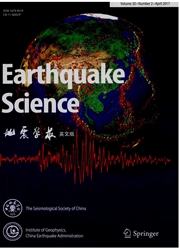

 中文摘要:
中文摘要:
利用"中国地震科学台阵探测"在南北地震带北段布设的670套宽频带地震台站记录到的面波资料,使用新近发展的程函方程面波层析成像方法,获得了青藏高原东北缘及周边地区12-60 s周期范围比以往成像结果具有更高分辨率的瑞利面波相速度分布图像.青藏高原东北缘的祁连褶皱系西段、秦岭褶皱系西段和松潘—甘孜褶皱系,在16-60 s周期范围内均显示出明显的低速异常分布,表明该地区的地壳力学强度较低,在强烈的构造应力作用下易发生形变.与西段不同,祁连褶皱系东段和秦岭褶皱系中段的相速度分布特征揭示,其中下地壳的速度明显高于高原内部区域.鄂尔多斯块体整体上表现为稳定块体具有的高速特征,但其西部边缘在中上地壳的速度比块体中部地区偏低,且存在一定的不均匀性.鄂尔多斯块体西北缘的临河断陷盆地和西缘的银川断陷盆地,在较短的周期范围内(12-20 s)表现为局部低速特征,但与银川断陷盆地不同,临河断陷盆地的低速特征可一直延续至60 s周期以上,表明该盆地下方地壳及上地幔速度明显偏低,可能与深部热作用有关.阿拉善块体与其北部地区的速度差异主要表现在中上地壳,这一现象值得今后进一步探讨.基于程函方程面波层析成像方法给出了青藏高原东北缘及周边地区高分辨率的成像结果,揭示了以往面波层析成像难以获得的深部细节特征,为该地区的深部构造研究提供了新的信息.
 英文摘要:
英文摘要:
Based on surface wave data recorded by 670 dense deployed seismic stations of ChinArray,high-resolution Rayleigh wave phase velocity images between 12 s and 60 s are obtained using the recently developed Eikonal tomography method.The lateral resolution is higher than ever before.The results show that from periods of 16 s to 60 s, distinct low-velocity anomalies exist in the western and middle Qilian fold system and Songpan-Garzê fold system.It suggests low mechanical strength of the crust in these areas,which makes the crust easy to deform under strong tectonic stress.Different from western parts,phase velocities of middle-lower crust in the eastern Qilian fold system and eastern Qinling fold system are higher than that in the interior of the Tibetan plateau.The Ordos block behaves as a stable massif,featured by high-velocity anomalies.However,in upper and middle crust,local low-velocity anomalies at periods 12 s to 20 s are present in the Linhe rift basin and Yinchuan rift basin.Different from the Yinchuan rift basin,low-velocity anomalies in the Linhe rift basin extend to 60 s or more.It indicates low velocity in crust and upper mantle beneath the Linhe rift basin,which may be associated with the thermal process from deep mantle.The velocity difference between the Alxa block and its adjacent northern area mainly exists in upper-middle crust,which needs to be further discussed.The high-resolution images determined with Eikonal tomography in and around the northeastern margin of the Tibetan plateau reveal more detailed deep structure than previous surface wave tomography results and provide new information for research of deep structure in this region.
 同期刊论文项目
同期刊论文项目
 同项目期刊论文
同项目期刊论文
 期刊信息
期刊信息
